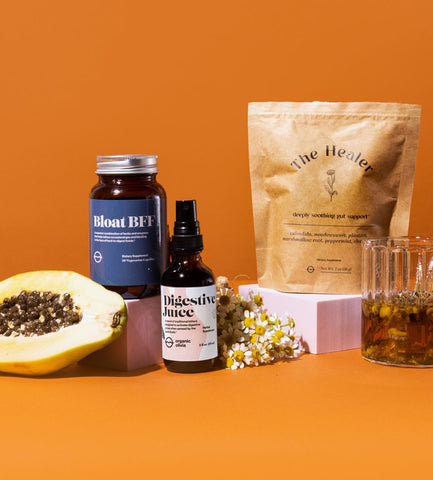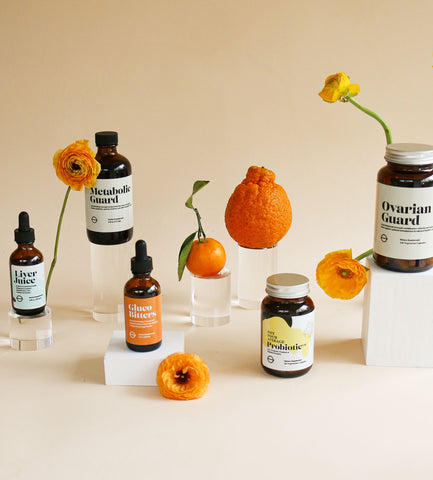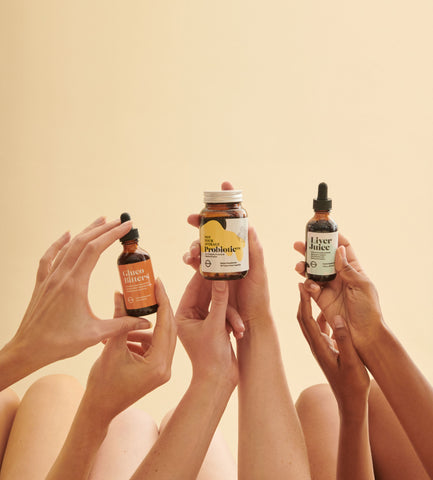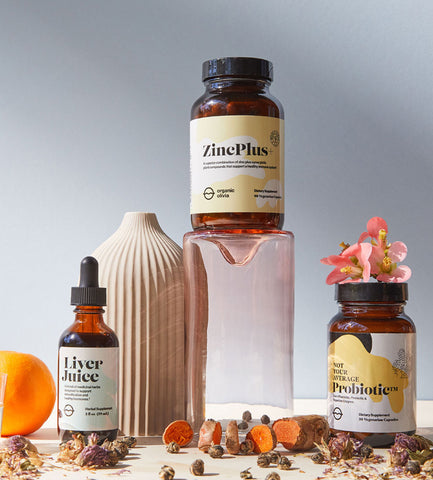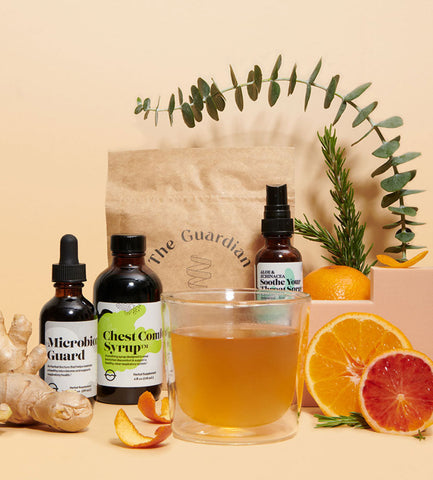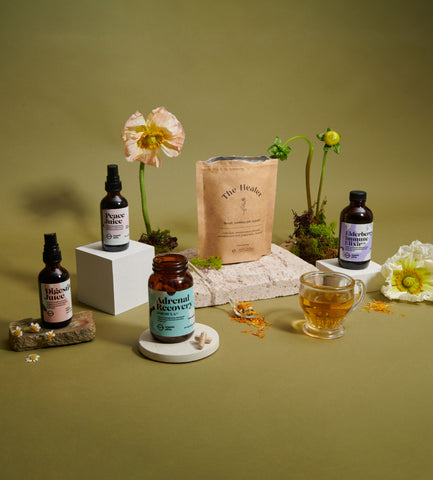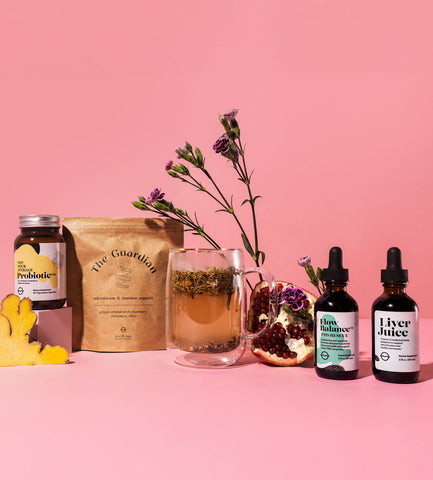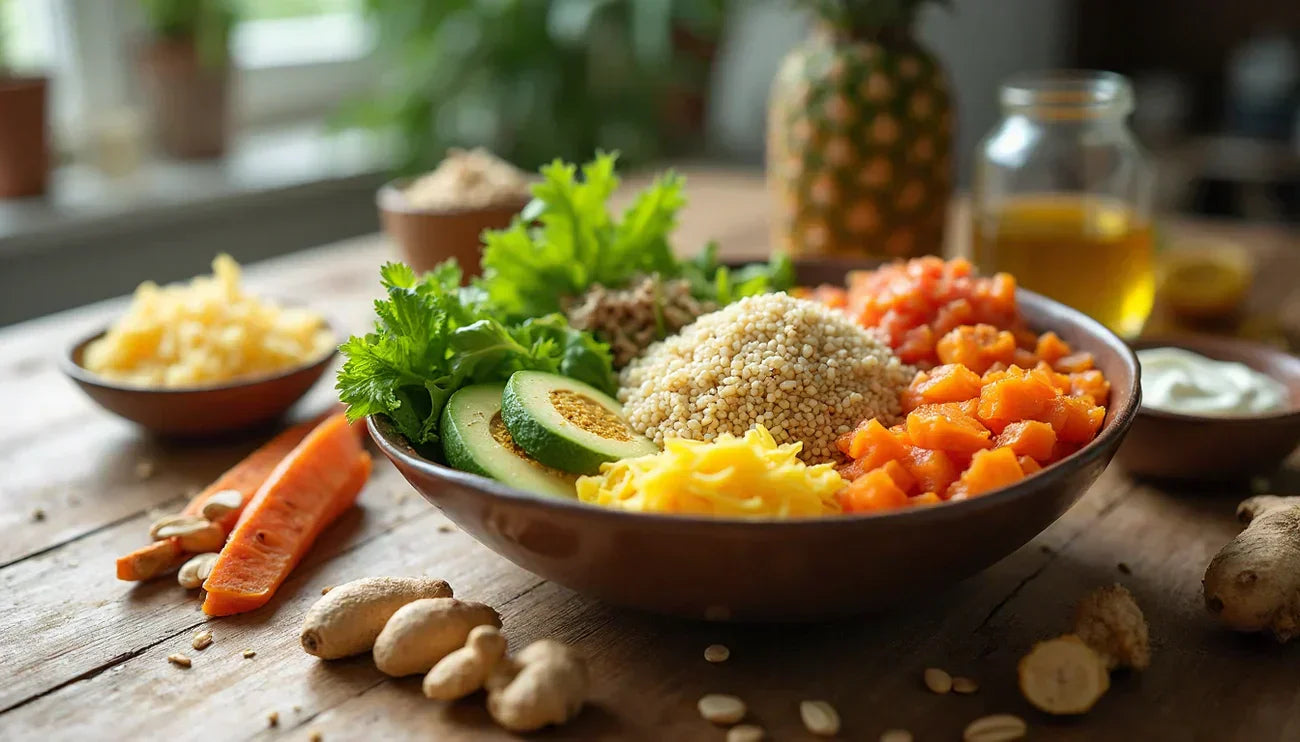Does this sound familiar? You treat a yeast infection or bacterial vaginosis, feel better for a while, then find yourself dealing with the same uncomfortable symptoms weeks or months later. You're not imagining the pattern, and you're definitely not alone. Millions of women face this frustrating cycle every year, spending countless dollars on treatments that provide only temporary relief.
Here's what most women don't realize: your vaginal health issues might actually be starting in your gut.
I know it sounds surprising, but recent research has uncovered a direct biological pathway between your digestive system and your vaginal microbiome. Scientists have found the same bacterial species living in both the rectum and vagina of 36% of pregnant women studied. Even more fascinating, 68% of these shared species had identical genetic profiles. Another study revealed that about 44% of bacterial species occurred in both the vaginal and rectal microbiota.
This explains so much! It's why your vaginal flora imbalance often shows up alongside digestive symptoms. When the beneficial lactobacilli in your system decrease and harmful bacteria or fungi take over, infections can develop as these problematic microbes migrate from the rectum to the vagina. This discovery is changing how healthcare practitioners approach persistent vaginal health issues and recurrent infections.
Here's what you'll learn in this article: exactly how this gut-vagina connection works, why your recurring infections might be linked to what's happening in your digestive system, and most importantly, what you can do to support both systems naturally for lasting wellness, including the potential benefits of vaginal probiotics.
When Your Vaginal Health Feels Off: What's Really Happening?
The cycle is all too familiar for many women. You deal with irritation, unusual discharge, and uncomfortable symptoms that seem to come and go without warning. Standard treatments might provide temporary relief, but the problems keep returning. It's frustrating, and it often leaves you wondering what you're missing.
The truth is, most conventional approaches only scratch the surface. They focus on treating the symptoms you can see and feel, without addressing what's actually causing the imbalance in the first place. Getting to the bottom of persistent vaginal health issues means looking deeper than the obvious signs and understanding what a normal vaginal environment should look like.
The Most Common Culprits Behind Your Discomfort
The three main troublemakers behind vaginal health issues are bacterial vaginosis (BV), yeast infections, and general flora imbalances. While they might feel similar — causing discharge, itching, and burning — each has its own distinct cause.
Bacterial vaginosis develops when harmful bacteria multiply and overtake the beneficial lactobacilli that normally protect your vaginal environment. Think of it as the bad guys winning the battle against the good guys. The symptoms of bacterial vaginosis often include a fishy odor and grayish discharge. Yeast infections, on the other hand, occur when Candida species (usually Candida albicans) gets out of control and starts overgrowing. Both represent the same core problem: your delicate microbial balance has been disrupted, leading to an altered vaginal microbiota.
The real frustration comes from how often these conditions return. Research shows that about 50% of women with BV will deal with it again within 12 months of their initial treatment. Yeast infections aren't much better — roughly 40-45% of women will have at least one recurrence, and 5-8% struggle with chronic infections that just won't stay away.
This pattern points to something important: standard treatments might be missing a crucial piece of the puzzle.
Why Standard Treatments Keep Falling Short
Most conventional treatments are designed to kill harmful microbes. Antibiotics target bacterial vaginosis, and antifungals are used for yeast infections. But these solutions rarely help rebuild your population of beneficial bacteria. That’s a problem because your vaginal environment relies on protective lactobacilli to stay balanced.
When antibiotics eliminate these good bacteria, they disrupt the microbiome not just in the vagina but also in the gut, which serves as the primary source of those beneficial microbes. If your gut can’t replenish the right bacteria, recurring infections become more likely.
Your gut health is central to this entire process. It doesn't just influence digestion. It helps regulate hormone levels, controls immune responses, and supplies the beneficial bacteria that help protect your vaginal microbiome. When gut imbalances occur, they can lead to inflammation and hormonal disruptions that weaken your vaginal defenses.
Unfortunately, standard treatments often ignore this deeper connection. They focus on immediate symptom relief without addressing the underlying cause. It's like mopping up a spill without fixing the leak. For lasting results, both the gut and vaginal microbiomes need to be supported together.
This is why targeted probiotic formulations like vaginal probiotics are gaining attention. They work on both your gut and vaginal microbiomes at the same time, addressing the source of the problem instead of just putting a Band-Aid on the symptoms.
Once you understand this connection, everything starts to make sense. The recurring infections, the digestive symptoms that seem unrelated, the treatments that work temporarily but don't last – all points back to the same root cause that needs to be addressed holistically.
The Science Behind the Gut-Vagina Connection
Your body has created an intricate biological highway between your digestive system and your vaginal microbiome. Scientists are just beginning to understand how sophisticated these pathways really are—and the discoveries are changing everything we know about women's reproductive health.
How Microbes Travel From Gut to Vagina
Your gut houses a stable community of microorganisms that don't just stay put. These bacteria can actually migrate to your vaginal area through physical proximity. It's surprisingly simple—bacteria from your rectum travel a short distance to colonize your vagina. Both environments share five common bacterial families: Firmicutes, Bacteroidetes, Proteobacteria, Actinobacteria, and Fusobacteria.
Even more interesting? The beneficial Lactobacillus species that should dominate a healthy vaginal microbiome actually originate from your gut. This discovery explains why oral probiotics can effectively support vaginal health. When you take probiotics by mouth, they establish beneficial bacteria upstream in your digestive system, which then travel to colonize your vaginal environment. Research proves this works – scientists can detect orally administered probiotic strains in vaginal samples later.
This migration pathway also explains a frustrating pattern many women experience. Antibiotics disrupt both your gut and vaginal microbiomes at the same time. When the good bacteria are wiped out in both locations, opportunistic troublemakers like Candida albicans and E. coli have the perfect opportunity to flourish everywhere.
BV and Gut Health: A Two-Way Street
The relationship between bacterial vaginosis and gut health works in both directions. When vaginal dysbiosis occurs, it triggers inflammation that extends far beyond your reproductive tract. Research with mice shows that Gardnerella vaginalis infection in the vagina actually stimulates inflammatory pathways in the colon too.
The reverse is also true. Poor gut health increases your risk of vaginal infections through several mechanisms:
-
Your gut becomes a reservoir for trouble: Harmful microbes from your digestive system can travel to colonize your vagina
-
Inflammation spreads throughout your body: Gut dysbiosis triggers widespread inflammatory responses that weaken your vaginal defenses
-
Your immune system gets confused: A healthy gut trains your immune system to respond appropriately throughout your entire body
This two-way communication explains why recurrent BV so often shows up alongside digestive symptoms. Treating just one system while ignoring the other usually leads to disappointing results.
Your Gut Controls Your Hormones Too
Perhaps the most fascinating discovery involves how your gut microbiome influences your hormonal balance, especially estrogen. Specific gut bacteria produce an enzyme called β-glucuronidase that directly affects how estrogen circulates in your body.
When these bacteria function properly, they help maintain appropriate estrogen levels by preventing too much hormone from being eliminated. This matters tremendously because estrogen directly impacts your vaginal health through a cascade of effects:
-
Estrogen increases glycogen storage in your vaginal cells
-
Glycogen serves as food for beneficial Lactobacillus species
-
Lactobacillus converts glycogen to lactic acid, creating the acidic environment that protects against harmful bacteria
Your gut microbiome essentially "talks" to your vaginal microbiome through these hormonal messengers. This relationship becomes especially obvious during major life transitions like puberty, menstruation, and menopause—times when hormonal fluctuations affect both your gut and vaginal bacteria.
Understanding these connections makes it clear why addressing gut health becomes essential for resolving persistent vaginal issues. Multi-strain probiotics that target both systems simultaneously offer a much more complete approach than treatments focused solely on vaginal symptoms.
What Happens When Things Go Wrong
When your microbiome balance gets disrupted, it sets off a cascade of problems that can make vaginal health issues incredibly stubborn to resolve. The effects go far beyond just uncomfortable symptoms — they create ongoing vulnerability that explains why you might feel stuck in a cycle of recurring infections.
When Your Vaginal Flora Gets Out of Balance
Here's what happens inside your body when things go sideways. Your vaginal microbiome depends on beneficial lactobacilli to keep everything running smoothly. When these good bacteria can no longer dominate the environment, you end up with what's called vaginal dysbiosis. This imbalance leaves you vulnerable to all sorts of infections and health problems, including urinary tract infections and pelvic inflammatory disease.
What's particularly frustrating is that up to 84% of people with bacterial vaginosis don't even experience symptoms. You could have an imbalance brewing without knowing it!
Normally, your lactobacilli work hard to maintain an acidic pH between 3.8 and 4.5 by producing lactic acid and hydrogen peroxide. This acidic environment naturally keeps harmful microorganisms from taking over. However, when dysbiosis occurs, your vaginal pH rises above 4.5. Suddenly, anaerobic bacteria like Gardnerella, Prevotella, and Atopobium have the perfect conditions to flourish.
Several everyday factors can trigger this imbalance:
-
Antibiotic use
-
Hormonal fluctuations
-
Stress and poor sleep
-
Harsh hygiene products
-
Unprotected sexual activity
The numbers are staggering — bacterial vaginosis affects approximately 25% of women globally, making it the most common vaginal infection among reproductive-aged women.
Can Bad Gut Health Really Cause Yeast Infections?
Absolutely! Your digestive tract naturally contains Candida albicans, and your gut serves as the main reservoir for these fungi. When you take antibiotics, they wipe out the beneficial bacteria that normally keep Candida in check. Without this natural protection, yeast can multiply rapidly, leading to vulvovaginal candidiasis.
Here's the concerning part — Candida can actually travel from your gut to your vagina through physical proximity. Research confirms that gut fungal dysbiosis directly influences vaginal yeast infections. Studies even show that antifungal treatments targeting the gut can substantially alter vaginal bacterial communities.
It gets worse. Antibiotics used to treat bacterial vaginosis often lead to vaginal candidiasis because they eliminate protective lactobacilli throughout your entire body. You end up in a vicious cycle where treating one condition potentially triggers another.
How Dysbiosis Wreaks Havoc on Your Immunity
Dysbiosis doesn't just stay put — it triggers inflammatory responses throughout your entire body. A balanced vaginal microbiome typically maintains low inflammation levels with minimal production of pro-inflammatory cytokines. However, when harmful bacteria take over, they release substances that compromise your vaginal epithelial cells.
These disruptions trigger the release of inflammatory markers like IL-1β, IL-8, and TNF-α. This inflammatory cascade affects your local immunity in three critical ways:
First, it compromises your natural protective barriers. Second, it impairs normal immune cell function and migration. Third, chronic inflammation creates a favorable environment for recurring infections to take hold.
The consequences can be serious. Vaginal dysbiosis has been linked to increased risk of sexually transmitted infections, pregnancy complications like preterm birth, and potentially even cancer. Research shows that an imbalanced vaginal microbiome significantly increases your susceptibility to infections like HPV, HIV, and herpes.
This is exactly why addressing both your gut and vaginal health together offers the most effective approach for resolving persistent issues. You can't fix one without supporting the other.
How to Support Both Gut and Vaginal Health
Now that you understand the connection between your gut and vaginal health, let's talk about what you can actually do about it. The good news is that supporting both systems doesn't require complicated protocols. You have more control than you might think!
Choose the Right Probiotics for Vaginal Health
Not all probiotics are created equal when it comes to vaginal health. The specific strains you choose make all the difference. Research shows that Lactobacillus crispatus and Lactobacillus rhamnosus demonstrate the strongest benefits for vaginal microbiota in human clinical trials. These powerhouse strains produce hydrogen peroxide and maintain vaginal acidity, creating an environment that harmful bacteria and yeast simply can't thrive in.
I also recommend looking for formulas that include Lactobacillus reuteri and Lactobacillus gasseri. These strains have shown impressive results in preventing overgrowth of problematic bacteria like Gardnerella vaginalis and Candida species.
Here's what I've learned from working with clients: multi-strain formulations often provide superior results compared to single-strain options. Your microbiome is complex, so it makes sense that a multi-faceted approach works better.
The key is finding probiotic supplements that target both gut and vaginal ecosystems simultaneously. This recognizes the migration pathway between these systems that we discussed earlier. Some women may benefit from intravaginal probiotic administration in addition to oral supplements, especially when dealing with acute symptoms.
Foods That Help (and Hurt) Your Microbiomes
What you eat every day has a profound impact on both your gut and vaginal health. A fiber-rich diet with plenty of fruits, vegetables, and whole grains supports microbial diversity in the gut, which then influences your vaginal flora. Studies show that higher carbohydrate consumption correlates with increased abundance of beneficial Lactobacillus species, primarily L. crispatus and L. gasseri.
Here's what I recommend adding to your diet:
-
Fermented foods with live cultures like yogurt, kefir, kimchi, and sauerkraut
-
Prebiotic-rich foods that feed your beneficial bacteria
-
Low glycemic foods that don't fuel harmful microbes
Just as important as what you add is what you remove. Limit added sugars and highly processed foods can disrupt both gut microbiome. Trans fats and ultra-processed foods increase inflammation that compromises your vaginal defenses.
Don't Underestimate Stress and Sleep
This might surprise you, but managing stress is crucial for maintaining healthy microbiomes. High stress levels directly alter vaginal microbiota composition. Stress hormones can increase vaginal pH, which destabilizes the balance of vaginal flora, especially those protective lactobacilli.
Quality sleep supports your microbiome too. Research shows that total microbiome diversity positively correlates with increased sleep efficiency and total sleep time. Poor sleep is associated with disrupted microbial communities and increased inflammation.
Simple stress-reduction techniques like meditation, regular exercise, and even cognitive behavioral therapy benefit your mental wellbeing and directly support microbial health throughout your body.
For those seeking a solution that addresses both systems simultaneously, multi-strain probiotics like Flora-V contain four different Lactobacillus species plus a spore-based probiotic. This approach repopulates both gut and vaginal microbiomes, targeting the root causes of recurring issues rather than just masking symptoms.
A Natural Solution of Super Herbs
Now that you understand how closely your gut and vaginal health are connected, you need a solution that addresses both systems together. Flora-V was specifically formulated with this dual-system approach in mind.

Flora-V
A vaginal probiotic + clinically studied cranberry extract that targets urinary tract health, normal pH levels, odor, and yeast balance.*
STAR HERB: Cranberry
What Makes Flora-V Different
Flora-V contains clinically studied ingredients that work on both your vaginal and gut microbiomes at the same time. The formula includes Lactospore®, a spore-forming Bacillus coagulans probiotic that helps create the optimal acidic environment your body needs in both locations. You'll also get Cranberex™, a potent cranberry extract with 15% proanthocyanidin (PAC) content that starts working within 6 hours to fight urinary imbalance.
What sets Flora-V apart is its focus on strains that actually colonize your vaginal environment. Most probiotics only target digestive health, but capsule contains strains specifically chosen for their ability to restore vaginal pH and create an environment where pathogenic microorganisms can't thrive.
How It Supports Both Systems
Research confirms that oral probiotics can reach your vagina effectively. Specific strains like Lactobacillus rhamnosus GR-1® and Lactobacillus reuteri RC-14® have been shown to "translocate to the vaginal environment even if they are taken orally". This means Flora-V works throughout your system, not just locally.
Once these beneficial bacteria establish themselves, they get to work:
-
Attaching to vaginal mucosa to block harmful bacteria
-
Producing lactic acid to keep your vaginal pH at optimal levels
-
Creating antimicrobial substances like bacteriocins and hydrogen peroxide
-
Supporting your immune function through healthy cell interactions
Real Results You Can Count On
Clinical trials show that probiotics dramatically reduce how often vaginal infections come back. A comprehensive analysis of 30 studies found that probiotic intervention reduced vaginitis recurrence by 73% and improved cure rates by 128%.
The multi-strain approach gives you complementary benefits. Some strains excel at producing hydrogen peroxide, while others are better at sticking to your epithelial cells or making specific antimicrobial compounds. Together, they create a complete defense system.
Women typically notice improvements in symptoms like unusual vaginal discharge, odor, and discomfort. Even better, probiotics help establish long-term vaginal flora balance instead of just masking symptoms temporarily. This makes them a much better option than repeated antibiotic treatments, which often just perpetuate the cycle of imbalance you're trying to escape.
Take Back Control of Your Health
Now you understand why those recurring vaginal infections keep coming back despite your best efforts to treat them. The missing piece of the puzzle has been right there all along — your gut health.
This connection between your digestive system and vaginal microbiome changes everything. Instead of chasing symptoms with endless rounds of antibiotics and antifungals, you can finally address what's really driving those frustrating cycles. When you support both systems together, you're tackling the root cause instead of just putting a band-aid on the problem.
The research is clear. Your gut serves as the command center for your vaginal health, sending beneficial bacteria downstream to establish the protective acidic environment your vagina needs. When gut dysbiosis disrupts this process, you become vulnerable to the very infections that have been plaguing you.
What you eat matters more than you might have realized. Every time you choose fiber-rich whole foods over processed options, you're feeding the beneficial bacteria that protect both your gut and vaginal health. When you manage stress and prioritize quality sleep, you're supporting the delicate microbial balance that keeps infections at bay.
The solution isn't complicated, but it does require a different approach than conventional medicine typically offers. Multi-strain probiotics like Flora-V represent this new understanding — they work with your body's natural pathways to restore balance in both systems simultaneously.
Your journey to better health begins with this knowledge. Use it to make informed choices that support your body's incredible ability to heal and maintain balance. Consider exploring alternative treatments like a vaginal probiotic and personalized medicine approaches that take your unique microbiome into account. By addressing both your gut and vaginal health together, you're setting the stage for long-term wellness and freedom from recurring infections.



